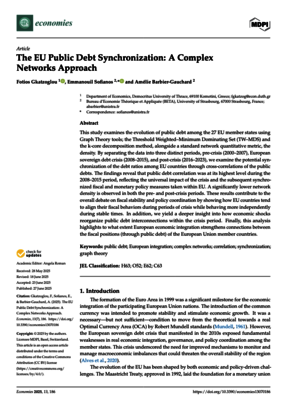Abstract
This study examines the evolution of public debt among the 27 EU member states using Graph Theory tools; the Threshold Weighted–Minimum Dominating Set (TW–MDS) and the k-core decomposition method, alongside a standard network quantitative metric, the density. By separating the data into three distinct periods, pre-crisis (2000–2007), Europeansovereign debt crisis (2008–2015), and post-crisis (2016–2023), we examine the potential synchronization of the debt ratios among EU countries through cross-correlations of the public debts. The findings reveal that public debt correlation was at its highest level during the 2008–2015 period, reflecting the universal impact of the crisis and the subsequent synchronized fiscal and monetary policy measures taken within EU. A significantly lower network density is observed in both the pre- and post-crisis periods. These results contribute to the overall debate on fiscal stability and policy coordination by showing how EU countries tend to align their fiscal behaviors during periods of crisis while behaving more independently during stable times. In addition, we yield a deeper insight into how economic shocks reorganize public debt interconnections within the crisis period. Finally, this analysis highlights to what extent European economic integration strengthens connections between the fiscal positions (through public debt) of the European Union member countries.
Keywords: public debt; European integration; complex networks; correlation; synchronization; graph theory



